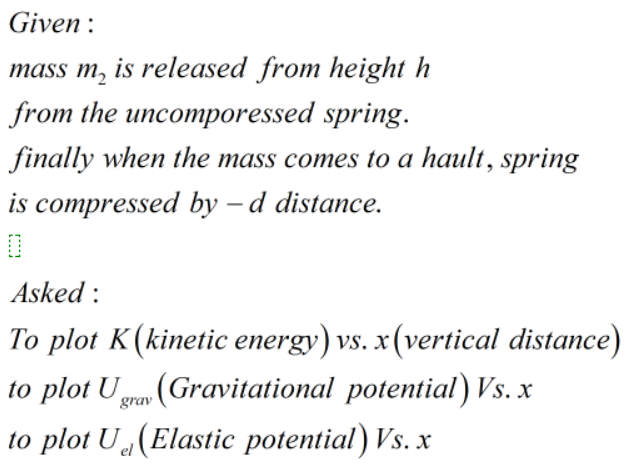On the axes below, make sketches of the kinetic energy (K), gravitational potential energy (Ugrav), and elastic potential energy (Uel) of the system on the y-axis as a function of the height of m2 on the x-axis, where the location y=0 is defined as the point where mass m2 collides with the spring. Note that the start of the x-axis is height h, and the end of the x-axis is height -d.
On the axes below, make sketches of the kinetic energy (K), gravitational potential energy (Ugrav), and elastic potential energy (Uel) of the system on the y-axis as a function of the height of m2 on the x-axis, where the location y=0 is defined as the point where mass m2 collides with the spring. Note that the start of the x-axis is height h, and the end of the x-axis is height -d.
College Physics
11th Edition
ISBN:9781305952300
Author:Raymond A. Serway, Chris Vuille
Publisher:Raymond A. Serway, Chris Vuille
Chapter1: Units, Trigonometry. And Vectors
Section: Chapter Questions
Problem 1CQ: Estimate the order of magnitude of the length, in meters, of each of the following; (a) a mouse, (b)...
Related questions
Question

Transcribed Image Text:**Topic: Energy in Oscillating Systems**
**Text Transcription:**
On the axes below, make sketches of the kinetic energy (\(K\)), gravitational potential energy (\(U_{\text{grav}}\)), and elastic potential energy (\(U_{\text{el}}\)) of the system on the \(y\)-axis as a function of the height of \(m_2\) on the \(x\)-axis, where the location \(y=0\) is defined as the point where mass \(m_2\) collides with the spring. Note that the start of the \(x\)-axis is height \(h\), and the end of the \(x\)-axis is height \(-d\).
**Graphs Description:**
1. **Kinetic Energy (\(K\)) Graph:**
- The vertical axis represents kinetic energy (\(K\)).
- The horizontal axis is labeled "height of mass \(m_2\) above the spring," ranging from \(h\) to \(-d\).
- The graph should show how kinetic energy varies as mass \(m_2\) moves from height \(h\) toward the spring.
2. **Gravitational Potential Energy (\(U_{\text{grav}}\)) Graph:**
- The vertical axis represents gravitational potential energy (\(U_{\text{grav}}\)).
- The horizontal axis is labeled "height of mass \(m_2\) above the spring," ranging from \(h\) to \(-d\).
- The graph should depict changes in gravitational potential energy as \(m_2\) approaches the spring.
3. **Elastic Potential Energy (\(U_{\text{el}}\)) Graph:**
- The vertical axis represents elastic potential energy (\(U_{\text{el}}\)).
- The horizontal axis is labeled "height of mass \(m_2\) above the spring," ranging from \(h\) to \(-d\).
- The graph should illustrate how elastic potential energy develops as \(m_2\) compresses the spring.
**Purpose:**
These sketches help visualize the transformation of energy types as \(m_2\) moves, collides, and interacts with the spring, providing insight into the principles of energy conservation in mechanical systems.
Expert Solution
Step 1

Step by step
Solved in 2 steps with 7 images

Knowledge Booster
Learn more about
Need a deep-dive on the concept behind this application? Look no further. Learn more about this topic, physics and related others by exploring similar questions and additional content below.Recommended textbooks for you

College Physics
Physics
ISBN:
9781305952300
Author:
Raymond A. Serway, Chris Vuille
Publisher:
Cengage Learning

University Physics (14th Edition)
Physics
ISBN:
9780133969290
Author:
Hugh D. Young, Roger A. Freedman
Publisher:
PEARSON

Introduction To Quantum Mechanics
Physics
ISBN:
9781107189638
Author:
Griffiths, David J., Schroeter, Darrell F.
Publisher:
Cambridge University Press

College Physics
Physics
ISBN:
9781305952300
Author:
Raymond A. Serway, Chris Vuille
Publisher:
Cengage Learning

University Physics (14th Edition)
Physics
ISBN:
9780133969290
Author:
Hugh D. Young, Roger A. Freedman
Publisher:
PEARSON

Introduction To Quantum Mechanics
Physics
ISBN:
9781107189638
Author:
Griffiths, David J., Schroeter, Darrell F.
Publisher:
Cambridge University Press

Physics for Scientists and Engineers
Physics
ISBN:
9781337553278
Author:
Raymond A. Serway, John W. Jewett
Publisher:
Cengage Learning

Lecture- Tutorials for Introductory Astronomy
Physics
ISBN:
9780321820464
Author:
Edward E. Prather, Tim P. Slater, Jeff P. Adams, Gina Brissenden
Publisher:
Addison-Wesley

College Physics: A Strategic Approach (4th Editio…
Physics
ISBN:
9780134609034
Author:
Randall D. Knight (Professor Emeritus), Brian Jones, Stuart Field
Publisher:
PEARSON